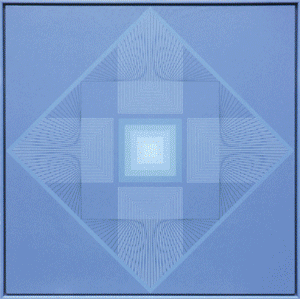- Transmission Difficulties
- Vancouver Painting in the 1960s
- A painting is a pitiable thing . . .
- The experience of a work of art . . .
- A painting is mediumistic . . .
- By Scott Watson
18.
Michael Morris (another one-time Kiyooka student) returned from his studies at the Slade in 1965, bringing with him the gouaches he had executed in London as well as his enthusiasm for the new avant-gardes of destructionism (Ralph Ortiz), Actionism and Fluxus. Morris developed the gouaches into canvases throughout the next few years and earned a reputation as one of Canada's most promising artists. Critical response to his work focused on his paintings, although these paintings, following the major arguments of the day, tended toward sculpture.
Morris's hard-edge compositions were most often hand-applied without benefit of masking tape; the hand-held brush ironically undercut the notion that such compositions were autonomous, self-referential and impersonal, qualities that had been seen as critical values of the hard-edge approach. Furthermore, Morris's designs call forth a skein of references from Babylonian architecture via Art Deco, Busby Berkeley musicals and Hollywood glamour. Morris's sense of referentiality was conceptual, that is the referential structure informing the painting as a work of art. He worked with grey scales and colour spectrums partly as an homage to film, but more particularly to call forth the question of reproducibility; his scales refer to those used by photographers when they are photographing paintings for reproduction. This region of approximation, in which the "reproduction" can never reproduce the original, but in which the "original" is intended for reproduction, animated Pop Art and to some extent the entirety of painting during the sixties. It was especially acute in remote Vancouver, but only Morris attended to it as a subject for painting.
In 1968, Morris began his last series on canvas . . .
Michael Morris (another one-time Kiyooka student) returned from his studies at the Slade in 1965, bringing with him the gouaches he had executed in London as well as his enthusiasm for the new avant-gardes of destructionism (Ralph Ortiz), Actionism and Fluxus. Morris developed the gouaches into canvases throughout the next few years and earned a reputation as one of Canada's most promising artists. Critical response to his work focused on his paintings, although these paintings, following the major arguments of the day, tended toward sculpture.
Morris's hard-edge compositions were most often hand-applied without benefit of masking tape; the hand-held brush ironically undercut the notion that such compositions were autonomous, self-referential and impersonal, qualities that had been seen as critical values of the hard-edge approach. Furthermore, Morris's designs call forth a skein of references from Babylonian architecture via Art Deco, Busby Berkeley musicals and Hollywood glamour. Morris's sense of referentiality was conceptual, that is the referential structure informing the painting as a work of art. He worked with grey scales and colour spectrums partly as an homage to film, but more particularly to call forth the question of reproducibility; his scales refer to those used by photographers when they are photographing paintings for reproduction. This region of approximation, in which the "reproduction" can never reproduce the original, but in which the "original" is intended for reproduction, animated Pop Art and to some extent the entirety of painting during the sixties. It was especially acute in remote Vancouver, but only Morris attended to it as a subject for painting.
In 1968, Morris began his last series on canvas . . .

